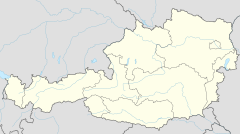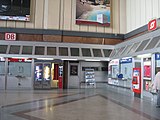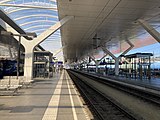
Wien Westbahnhof is a major Austrian railway station, the original starting point of the West railway (Westbahn) and a former terminus of international rail services. In 2015, its role changed with the opening of Vienna's new main station and Westbahnhof is now mainly a commuter station and the terminus of private rail operator WESTbahn's intercity service from Salzburg. Locally, Wien Westbahnhof is served by S-Bahn line S50 and U-Bahn lines U3 and U6. Six tram lines converge on Europaplatz in front of the station, although none go into the city centre. There are also buses to the airport.

Würzburg Hauptbahnhof is a railway station for the city of Würzburg in the German state of Bavaria. It was opened in 1864 to the north of the inner city as a replacement for the former Ludwigsbahnhof in the city centre, the capacity of which had been exhausted by the dramatic increase of rail traffic. Even today, Würzburg station is one of the major stations in Bavaria, since it lies at the intersection of several heavily used rail corridors. In particular, the routes in the north–south direction from Hamburg and Bremen to Munich as well as in west–east direction from the Rhine-Ruhr and Rhine-Main to Nuremberg and Vienna. Apart from Aschaffenburg Hauptbahnhof, Würzburg is the only station in Lower Franconia to be served by Intercity-Express services. With its combination of rail, tram and bus services, the station is the main hub for public transport in the city and the district of Würzburg.

München Hauptbahnhof or Munich Central Station is the main railway station in the city of Munich, Germany. It is one of the three stations with long-distance services in Munich, the others being Munich East station and Munich-Pasing station (München-Pasing). München Hauptbahnhof sees about 450,000 passengers a day, which puts it on par with other large stations in Germany, such as Hamburg Hauptbahnhof and Frankfurt (Main) Hauptbahnhof. It is classified by Deutsche Bahn as a category 1 station, one of 21 in Germany and two in Munich, the other being München Ost. The mainline station is a terminal station with 32 platforms. The subterranean S-Bahn with 2 platforms and U-Bahn stations with 6 platforms are through stations.
Duisburg Hauptbahnhof is a railway station in the city of Duisburg in western Germany. It is situated at the meeting point of many important national and international railway lines in the Northwestern Ruhr valley.

Essen Hauptbahnhof is a railway station in the city of Essen in western Germany. It is situated south of the old town centre, next to the A 40 motorway. It was opened in 1862 by the Bergisch-Märkische Eisenbahn. However, the station was not the first in Essen: as the station called Essen on the Köln-Mindener Eisenbahn was opened in 1847.

Bielefeld Hauptbahnhof is the main station in the region of Ostwestfalen-Lippe, in the German state of North Rhine-Westphalia. It is an important station because of the size of the city of Bielefeld and its location at the Bielefeld Pass, which makes it a node for long-distance and regional traffic. It was opened in 1847 with the opening of the Cologne-Minden trunk line. It is classified by Deutsche Bahn as a category 2 station.

Wien Hauptbahnhof, Vienna Central Station or Vienna Main Station is the main railway station in Vienna, Austria, located in the Favoriten district. It became fully operational in December 2015, linking major railway lines from the north, east, south and west, and replacing the old Wien Südbahnhof terminus. With 268,000 daily commuters it is Austria's busiest long-distance railway station. Aside from being voted "Austria's most beautiful railway station", it was also second in Consumer Choice Center's ranking of "Top 10 Railway Stations for Passenger Convenience in Europe".

Railjet is a high-speed rail service in Europe operated by Austrian Federal Railways (ÖBB) and Czech Railways (ČD). Branded as Railjet Express (RJX) for the fastest services and as Railjet (RJ) for services with additional stops, it was introduced in 2008 and operates at speeds of up to 230 km/h (143 mph). Railjet is ÖBB's premier service and operates both domestically within Austria and on international services to adjacent major cities in the Czech Republic, Germany, Switzerland, Italy, Hungary and Slovakia.

Innsbruck Hauptbahnhof is the main railway station in Innsbruck, the capital city of the Austrian federal state of Tyrol. Opened in 1853, the station is a major hub for western and central Austria. In 2019, it was the 8th-busiest station in the country, and the 2nd-busiest outside of Vienna after only Linz Hauptbahnhof, with 315 train movements and 38,500 passengers daily.

Rosenheim station is the main railway station in the city of Rosenheim in Bavaria, Germany. It is the seventh largest passenger station in Bavaria and an important railway hub between the Munich–Rosenheim railway line and the lines to Salzburg, Kufstein/Innsbruck and Mühldorf, as well as the Mangfall Valley Railway. Rosenheim is operated by DB Station&Service, a subsidiary of Deutsche Bahn AG, and is classified as a Category 2 station

The Munich–Rosenheim railway is a 65 kilometre-long double-track main line of the German railways. It connects Munich Hauptbahnhof with Rosenheim station, where it connects with the Rosenheim–Salzburg railway, which connects with the line to Vienna at Salzburg, and the line to Kufstein, which continues to Innsbruck and the Brenner line to Italy. The line is part of the "Main line for Europe", connecting Paris with Bratislava and Budapest and the almost identical line 17 of Trans-European Transport Networks (TEN-T). It is part of the line 1 of TEN-T. It is electrified at 15 kV, 16.7 Hz. It was opened between Munich and Rosenheim in 1871.

Graz Hauptbahnhof, abbreviated Graz Hbf, is the main railway station in Graz, the capital of the Austrian federal state Styria. The station is located some 2 kilometres (1.2 mi) west of the city centre, to which it is connected by tram.

Linz Hauptbahnhof or Linz Central Station is a railway station in Linz, the third largest city in Austria, and capital city of the federal state of Upper Austria. Opened in 1858, the station is the centrepiece of the Linz transport hub. It forms part of the Western Railway, and is also a terminus of the Pyhrn Railway, the Summerauer Railway, and the Linzer Lokalbahn (LILO). The station is owned by the Austrian Federal Railways (ÖBB); train services are operated by the ÖBB and the LILO. With 40,800 passengers daily in 2018/2019, it is the busiest station in Austria outside of Vienna, and the 7th-busiest overall.

Wels Hauptbahnhof, occasionally Wels Central Station or Wels central station is a railway station at Wels, which is the second largest city in the federal state of Upper Austria, in the north of Austria.

Klagenfurt Hauptbahnhof is the main railway station in Klagenfurt, capital of the Austrian state of Carinthia. It is an important railway junction in southern Austria.

Kufstein railway station serves the city of Kufstein, in the Kufstein district of the Austrian federal state of Tyrol. Opened in 1876, it is an Austrian-German border station, close to the border between Tyrol and Bavaria.
The Rosenheim–Salzburg railway is a continuous double track and electrified main line railway almost entirely within the German state of Bavaria. It is an international transport corridor, linking Rosenheim to Salzburg in Austria.

Freilassing station is located in the Upper Bavarian district of Berchtesgaden. It is the last German station on the railway line from Munich to Salzburg, a border station to Austria and the only station in the town of Freilassing.

The Salzburg S-Bahn is a large transport project in and around Salzburg in the Euroregion of Salzburg–Berchtesgadener Land–Traunstein, which crosses the border between Austria and Germany. Its S-Bahn network has been partially in operation since 2004 and its first stage was opened in 2014.

Traunstein station is the only station of the large district town of Traunstein in the German state of Bavaria. It has four main line platform tracks and two bay platform tracks and is classified by Deutsche Bahn as a category 4 station. The station is a rail junction and is located on the Rosenheim–Salzburg, Traunstein–Ruhpolding, Traunstein–Waging and Traunstein–Garching lines.


































